OVERVIEW
Purpose of the Educational Materials Component
This component of the handbook describes the AMA published Current Procedural Terminology (CPT®)[1] educational resources available. Material covered includes information about the educational resources and how to obtain them. Tables by implementer role are included as is a categorization of the materials into basic and advanced knowledge level to guide one to the appropriate resources.
Intended Audiences
This portion of the education handbook is relevant to all audiences, including
- Physicians/doctors
- Physician specialist groups
- Health service programs – quality improvement programs
- Health service delivery organizations
- Vendors of EMRs, EHRs, and specific clinical and functional areas
- Research organizations
- Local/national governments
- Local/national physician/doctor organizations/associations
- National information/standards and policy organizations
- Health information management professionals
- Those responsible for collecting service and procedure data
- Analysts
Learning Objectives
After reviewing the content in the Educational Materials Component, the reader is expected to be able to:
- Summarize the categories of CPT content educational materials.
- Identify which educational materials would be needed for various implementer roles.
- Identify sources for obtaining CPT content educational materials.
- List examples of educational materials at a basic level.
- Describe advanced level educational materials.
Modules
The Educational Materials Component includes two modules:
Module One: Summary of Available Educational Materials – Summarizes the CPT® resources available. A table stratifies the material by implementer role.
Module Two: CPT Content by Knowledge Level – Categorizes the resources listed in Module One into basic and advanced knowledge levels.
Each module is structured as follows. Note that some sections may not apply to a module.
Introduction – An introduction to the topic being discussed and why it is important.
- Intended Audience – The intended audience for the module.
- Learning Objectives – A list of learning objectives that will be covered in the module.
Main Module Content – The main content, which consists of five main sub-sections.
- Personnel – People who are involved in the topic.
- Tooling – Tooling and requirements that are required to apply the approach.
- Approach – The approach or methodology specific to a topic.
- Process – The interaction between personnel with other personnel and/or tooling.
- Challenges – Challenges associated with applying the approach.
Practical Use Example – An example of how the approach has been used.
Module One: Summary of Available Educational Materials
Introduction
This module provides a summary of the resources available through AMA’s printed catalogs (typically published biannually) and through its online AMA Store. A table stratifies the material by implementer role.
Intended Audiences
As noted above in the Educational Materials Component Overview.
Learning Objectives
After reviewing the content in this module, the reader is expected to be able to:
- Summarize the categories of CPT® content educational materials.
- Identify which educational materials would be needed for various implementer roles.
- Identify sources for obtaining CPT content educational materials.
Summary of Available Educational Materials
The educational materials published by the AMA as listed in the AMA’s 2020 Fall Catalog and on its online AMA Store were analyzed for inclusion.[2] Those selected were stratified by implementer role.
Approach
The AMA offers a variety of educational materials in its print catalogs and on the online AMA Store. In the catalog, categories include CPT Coding Resources, Documentation and Billing Resources, Coding Resource Packages, Impairment and Disability Evaluation Resources, and Clinical Reference Resources. Icons are used to indicate if academic educator materials are available and if an eBook or electronic format is offered.
The online AMA Store uses a menu bar that includes the categories of Product, Data Files, Licensing, CPT® Network, AMA Profiles, and My eLibrary.
The following table summarizes AMA product offerings listed in AMA’s 2020 Fall Catalog and on its online AMA Store. The 2020 Fall Catalog and AMA Store include information on how to obtain AMA product offerings, information regarding AMA licensing requirements, and contact information for AMA representatives available to provide additional information and to assist with licensing.

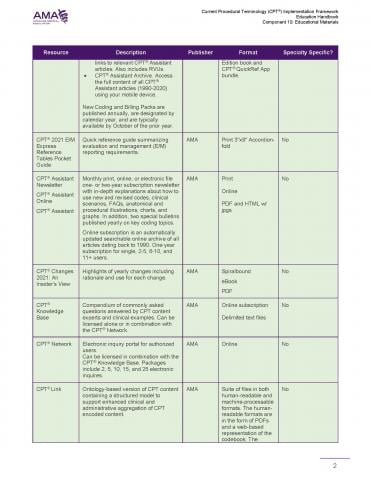
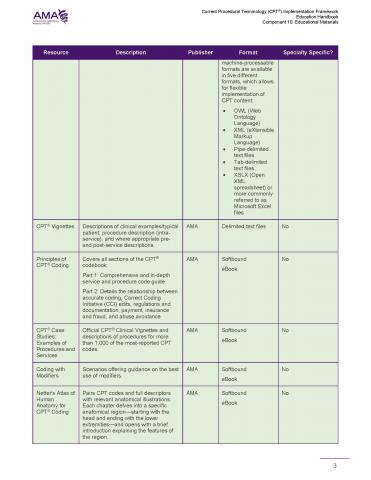
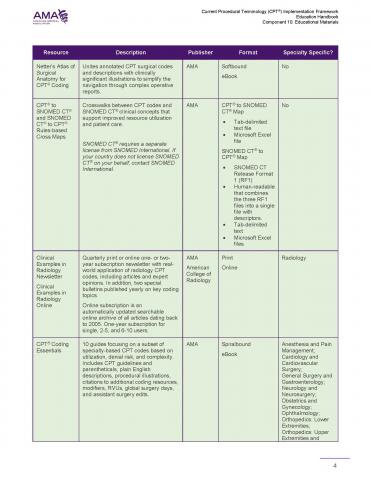
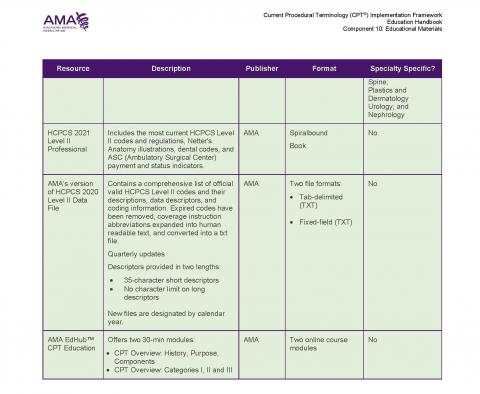
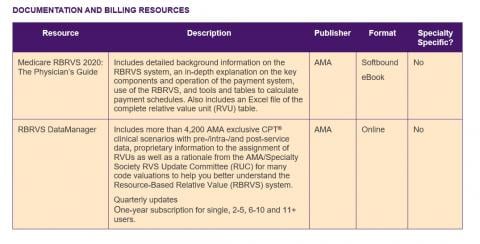
Education materials by implementer role
As the above list shows, the AMA publishes a range of resources. The following tables provide guidance on which resources would be most relevant taking into consideration an individual’s role.



Additional Information on Obtaining Educational Materials
The AMA Store provides contact information (https://commerce.ama-assn.org/store/ui/content/internationalsales) for organizations distributing CPT® content education resources outside the United States and its territories. For information on obtaining AMA product offerings not available through a listed third-party distributor, please contact the AMA directly.
General information regarding AMA licensing requirements is available on AMA’s website (https://www.ama-assn.org/practice-management/cpt/ama-cpt-licensing-overview), along with contact information for AMA representatives available to assist and provide additional information.
The CPT® QuickRef App mobile application is available for download in limited countries from the App Store or Google Play for mobile devices running OS 11.0 or later and Android 5.0 or later. Unlocking access to Coding and Billing Pack and CPT® Assistant archive is either through in-app transaction or by scanning a QR code included in the CPT® Professional Book and CPT® QuickRef App bundle.
Some products may not be obtained online by individuals/entities outside the United States but may be obtained by calling the AMA’s Unified Service Center.
MODULE TWO: CPT Content by Knowledge Level
Introduction
In this module, the resources listed in Module One are categorized into basic and advanced knowledge levels.
Intended Audiences
As noted above in the Educational Materials Component Overview.
Learning Objectives
After reviewing the content in this module, the reader is expected to be able to:
- List examples of educational material at a basic level.
- Describe advanced-level educational materials.
CPT Content by Knowledge Level
Certain educational resources published by the AMA are geared toward beginner-level individuals, while others are for those with higher level, advanced knowledge.
Tooling
The decision on which format is most beneficial for an individual’s role is dependent on how the content will be accessed. For example, if a physician practice utilizes an EMR that contains licensed CPT content, then a print product may not be needed.
Approach
A solid understanding of CPT content begins with establishing foundation-level knowledge. This is needed by anyone using CPT content and includes:
- Background and overview
- Organization and structure
- General principles and conventions
- Guidelines
- Steps for selecting from available descriptors
- Process for applying guidelines and selecting the correct descriptor and code
Advanced CPT content assumes the basic level of knowledge has been achieved.
The table that follows takes the resources listed in Module One and categorizes them into basic and advanced knowledge levels.
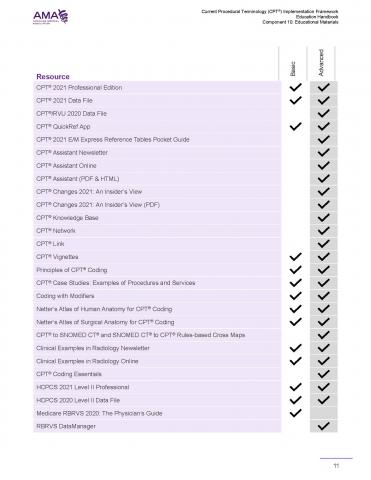
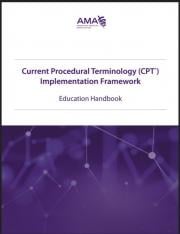
NAVIGATION
Component 3: Assessment of Feasibility
Component 7: Clinical Reporting
Component 9: Technical Requirements
Component 10: Educational Material